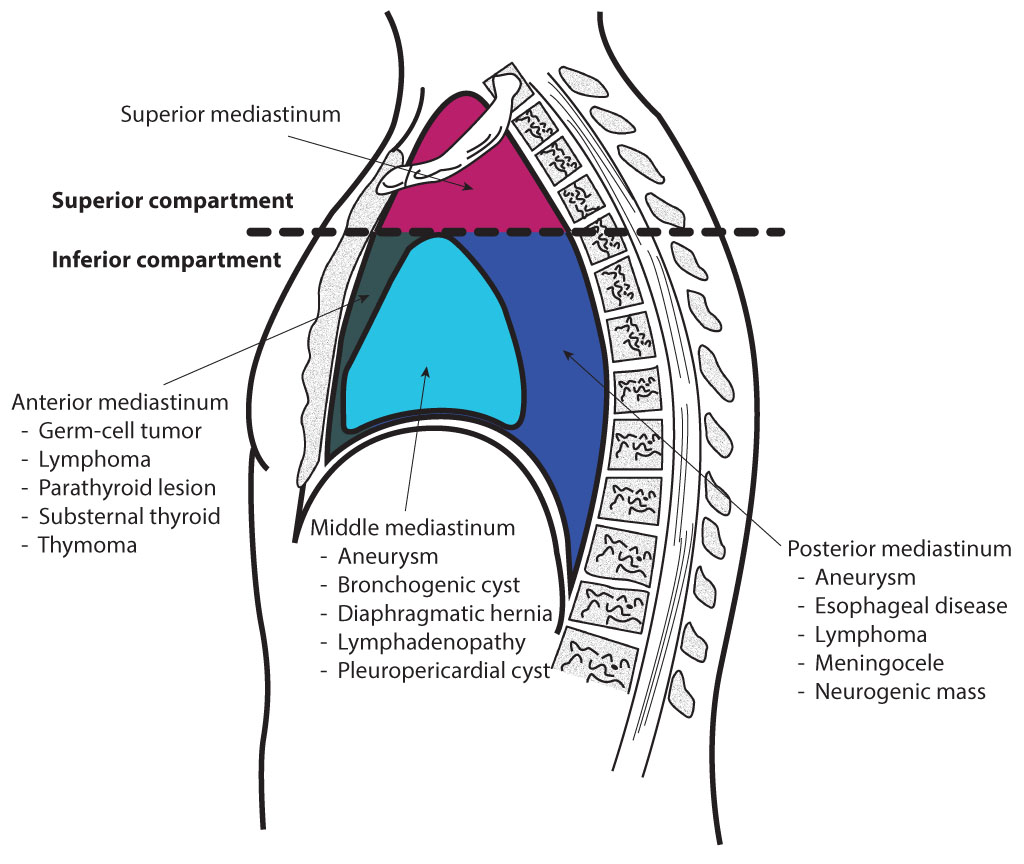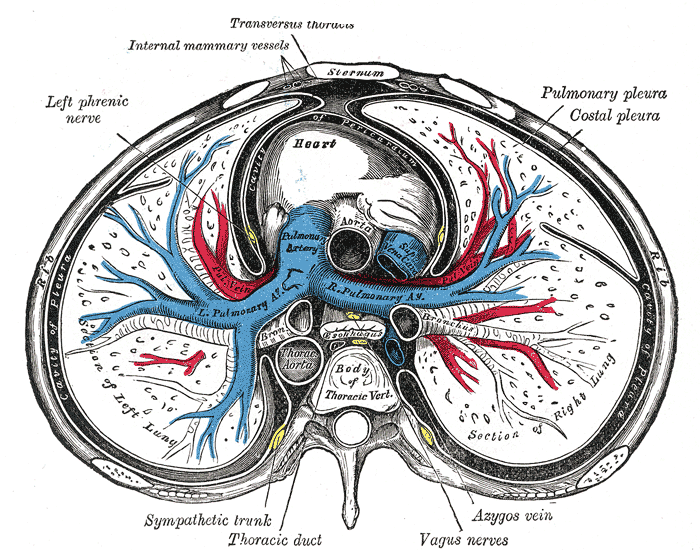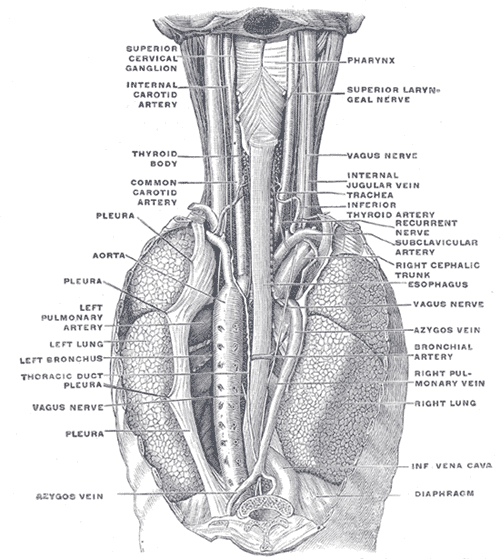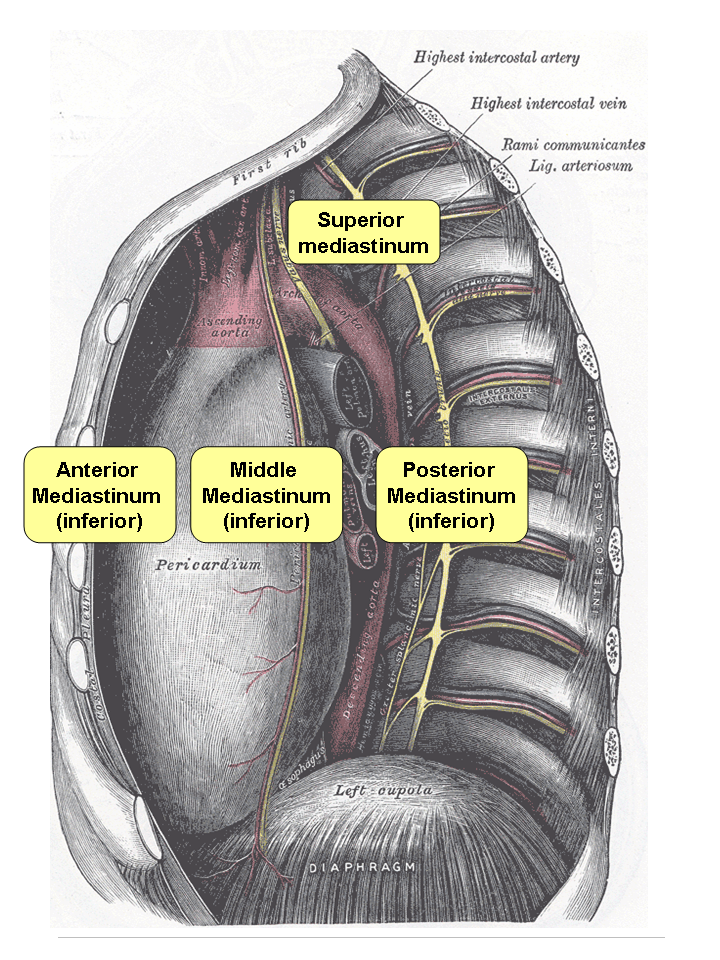[1]
Bardo DME, Biyyam DR, Patel MC, Wong K, van Tassel D, Robison RK. Magnetic resonance imaging of the pediatric mediastinum. Pediatric radiology. 2018 Aug:48(9):1209-1222. doi: 10.1007/s00247-018-4112-1. Epub 2018 Aug 4
[PubMed PMID: 30078043]
[2]
Ugalde PA, Pereira ST, Araujo C, Irion KL. Correlative anatomy for the mediastinum. Thoracic surgery clinics. 2011 May:21(2):251-72, ix. doi: 10.1016/j.thorsurg.2010.12.008. Epub
[PubMed PMID: 21477775]
[3]
Huang YX, Jin LZ, Lowe JA, Wang XY, Xu HZ, Teng YJ, Zhang HZ, Chi YL. Three-dimensional reconstruction of the superior mediastinum from Chinese Visible Human Female. Surgical and radiologic anatomy : SRA. 2010 Aug:32(7):693-8. doi: 10.1007/s00276-010-0627-3. Epub 2010 Feb 4
[PubMed PMID: 20131053]
[4]
Biondi A, Rausei S, Cananzi FC, Zoccali M, D'Ugo S, Persiani R. [Surgical anatomy of the anterior mediastinum]. Annali italiani di chirurgia. 2007 Sep-Oct:78(5):351-3
[PubMed PMID: 18338536]
[5]
Whitten CR, Khan S, Munneke GJ, Grubnic S. A diagnostic approach to mediastinal abnormalities. Radiographics : a review publication of the Radiological Society of North America, Inc. 2007 May-Jun:27(3):657-71
[PubMed PMID: 17495284]
[8]
Wang J, Li J, Liu G, Deslauriers J. Nerves of the mediastinum. Thoracic surgery clinics. 2011 May:21(2):239-49, ix. doi: 10.1016/j.thorsurg.2011.01.006. Epub
[PubMed PMID: 21477774]
[9]
Nason LK, Walker CM, McNeeley MF, Burivong W, Fligner CL, Godwin JD. Imaging of the diaphragm: anatomy and function. Radiographics : a review publication of the Radiological Society of North America, Inc. 2012 Mar-Apr:32(2):E51-70. doi: 10.1148/rg.322115127. Epub
[PubMed PMID: 22411950]
[11]
Shahoud JS, Kerndt CC, Burns B. Anatomy, Thorax, Internal Mammary (Internal Thoracic) Arteries. StatPearls. 2024 Jan:():
[PubMed PMID: 30726022]
[12]
Brakenhielm E, Alitalo K. Cardiac lymphatics in health and disease. Nature reviews. Cardiology. 2019 Jan:16(1):56-68. doi: 10.1038/s41569-018-0087-8. Epub
[PubMed PMID: 30333526]
[14]
Yasuda M, Osaki T, Fukuich Y, Kobayashi K, Iwata T, So T. Anterior mediastinal tumor as a solitary lymph node metastasis of occult thyroid carcinoma. Journal of surgical case reports. 2019 Feb:2019(2):rjz029. doi: 10.1093/jscr/rjz029. Epub 2019 Feb 14
[PubMed PMID: 30792843]
Level 3 (low-level) evidence
[15]
Park MS, Moon SH, Kim TH, Oh JK, Kim HJ, Park KT, Riew KD. Surgical Anatomy of the Longus Colli Muscle and Uncinate Process in the Cervical Spine. Yonsei medical journal. 2016 Jul:57(4):968-72. doi: 10.3349/ymj.2016.57.4.968. Epub
[PubMed PMID: 27189293]
[16]
Ueshima H. Transversus Thoracic Muscle Plane Block. Asian journal of anesthesiology. 2018 Dec:56(4):153. doi: 10.6859/aja.201812_56(4).0005. Epub
[PubMed PMID: 30922020]
[17]
Ferrand A, Roy SK, Faure C, Moussa A, Aspirot A. Postoperative noninvasive ventilation and complications in esophageal atresia-tracheoesophageal fistula. Journal of pediatric surgery. 2019 May:54(5):945-948. doi: 10.1016/j.jpedsurg.2019.01.023. Epub 2019 Jan 31
[PubMed PMID: 30814037]
[18]
Wise-Faberowski L, Asija R, McElhinney DB. Tetralogy of Fallot: Everything you wanted to know but were afraid to ask. Paediatric anaesthesia. 2019 May:29(5):475-482. doi: 10.1111/pan.13569. Epub 2019 Apr 15
[PubMed PMID: 30592107]
[19]
Salhiyyah K, Ashoub A, Diprose P, Barlow C. Knife in the superior mediastinum: Amazing escape. Annals of cardiac anaesthesia. 2017 Apr-Jun:20(2):247. doi: 10.4103/aca.ACA_251_16. Epub
[PubMed PMID: 28393789]
[20]
Saeyeldin AA, Velasquez CA, Mahmood SUB, Brownstein AJ, Zafar MA, Ziganshin BA, Elefteriades JA. Thoracic aortic aneurysm: unlocking the "silent killer" secrets. General thoracic and cardiovascular surgery. 2019 Jan:67(1):1-11. doi: 10.1007/s11748-017-0874-x. Epub 2017 Dec 4
[PubMed PMID: 29204794]
[21]
Chirica M, Kelly MD, Siboni S, Aiolfi A, Riva CG, Asti E, Ferrari D, Leppäniemi A, Ten Broek RPG, Brichon PY, Kluger Y, Fraga GP, Frey G, Andreollo NA, Coccolini F, Frattini C, Moore EE, Chiara O, Di Saverio S, Sartelli M, Weber D, Ansaloni L, Biffl W, Corte H, Wani I, Baiocchi G, Cattan P, Catena F, Bonavina L. Esophageal emergencies: WSES guidelines. World journal of emergency surgery : WJES. 2019:14():26. doi: 10.1186/s13017-019-0245-2. Epub 2019 May 31
[PubMed PMID: 31164915]
[22]
Jones SW, Williams FN, Cairns BA, Cartotto R. Inhalation Injury: Pathophysiology, Diagnosis, and Treatment. Clinics in plastic surgery. 2017 Jul:44(3):505-511. doi: 10.1016/j.cps.2017.02.009. Epub 2017 Apr 18
[PubMed PMID: 28576239]
[23]
Peters R, Peters O, Braak S, Verschakelen J. Pathology of the thymus on CT-imaging. JBR-BTR : organe de la Societe royale belge de radiologie (SRBR) = orgaan van de Koninklijke Belgische Vereniging voor Radiologie (KBVR). 2012 Sep-Oct:95(5):281-8
[PubMed PMID: 23198365]
[24]
Arabi RI, Aljudaibi A, Althumali AA, Rajb BS, Arja RD. Traumatic retrosternal hematoma leading to extra-pericardial cardiac tamponade-Case report. International journal of surgery case reports. 2019:61():30-32. doi: 10.1016/j.ijscr.2019.06.055. Epub 2019 Jun 27
[PubMed PMID: 31310858]
Level 3 (low-level) evidence
[25]
Ancion A, Robinet S, Lancellotti P. [Cardiac tamponade]. Revue medicale de Liege. 2018 May:73(5-6):277-282
[PubMed PMID: 29926566]
[26]
Saleh M, Ambrose JA. Understanding myocardial infarction. F1000Research. 2018:7():. pii: F1000 Faculty Rev-1378. doi: 10.12688/f1000research.15096.1. Epub 2018 Sep 3
[PubMed PMID: 30228871]
Level 3 (low-level) evidence
[27]
Johnson OW, Chick JF, Chauhan NR, Fairchild AH, Fan CM, Stecker MS, Killoran TP, Suzuki-Han A. The thoracic duct: clinical importance, anatomic variation, imaging, and embolization. European radiology. 2016 Aug:26(8):2482-93. doi: 10.1007/s00330-015-4112-6. Epub 2015 Dec 1
[PubMed PMID: 26628065]





